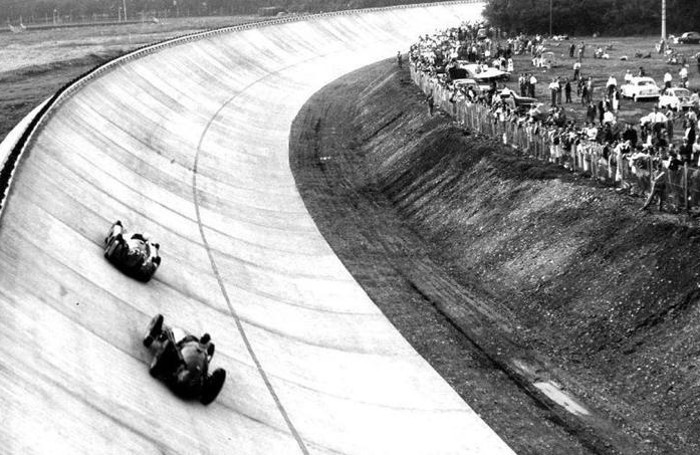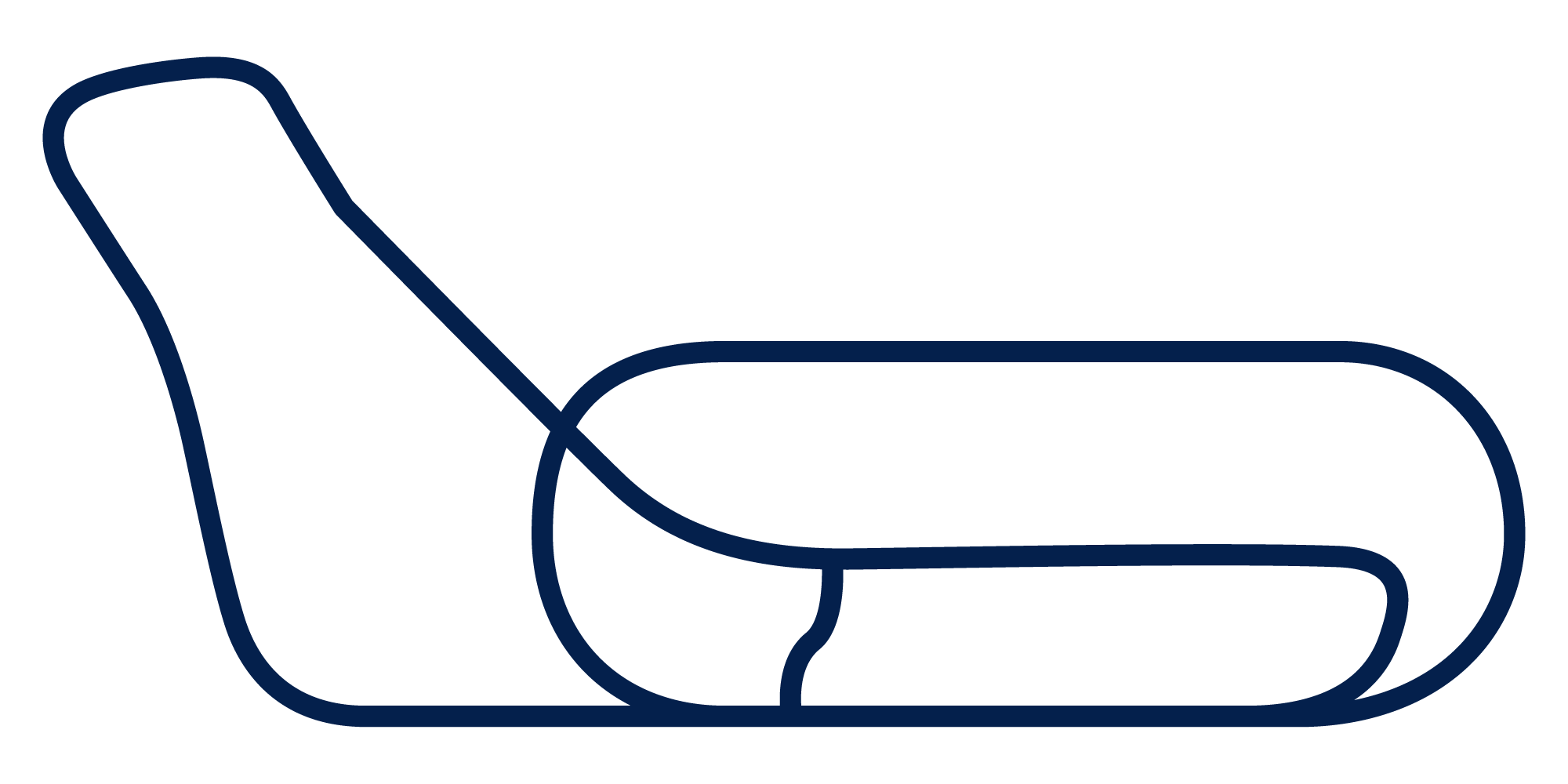The flyover of Monza
Built in 1955
Also known as the High Speed Ring or Catino di Monza , the Sopraelevata was built in 1955 , at a time when there was a strong need to push cars towards ever greater performance.. Its designers, the engineers Antonio Beri and Aldo Di Renzo , had a goal to achieve: to allow very high average speeds in uniform driving conditionsw, avoiding gear changes and the use of brakes. Therefore, a ring similar in development to the original one of 1922 was created, but with a more modern conception.

The route of the Sopraelevata
The track consisted of two semicircular curves with a radius of about 320 meters joined by two straights of 875 meters each, for a total length of the circuit of 4250 meters. The maximum inclination of the corners was 80% and would have allowed the riders to reach 300 km / h .
A few years later, the interpretation of the concept of speed took two directions. In Europe, it was intended as a search for technical performance, in America, as a performance of speed. This split led to the abandonment of the track and only from the end of the 90s did he return to interest in his destiny. Committees and petitions began to promote its conservation as the Elevated Tower had been and had to continue to be a protagonist of the history of world motoring .
The competitions held on the Soprelevata
1955: Formula 1 - Italian Grand Prix
The turnout was enormous: over 150,000 spectators invaded the racetrack for the event. Juan Manuel Fangio won in front of Taruffi and Castellotti, however favored by the boycott of the English teams that did not participate in the Grand Prix.
1956: Formula 1 - Italian Grand Prix
25 drivers entered the Formula 1 Italian Grand Prix. This time the English teams participated in the race after having carefully prepared their cars for days, which had to withstand the high stresses caused by the very fast circuit in Brianza.
1956: IV Supercortemaggiore Grand Prix - Sport up to 2000 cc
1957: 500 miles of Monza for F1 and Formula Indianapolis cars
The idea of the tender came to Eng. Bacciagaluppi, director of the racetrack, who invited Duane Carter, American race director, to participate. Carter was thrilled and scheduled the event for June 1957. The first edition of the 500 Miglia di Monza, however, was practically deserted by the Europeans, probably short of preparation for such an unusual and extremely fast race.
1958: 500 miles of Monza for F1 and Formula Indianapolis cars
The edition saw a consistent presence of European cars and drivers. Ferrari and Maserati built cars specifically for the event, while drivers such as Stirling Moss, Mike Hawthorn, Luigi Musso and Phil Hill decided months before they would not miss the event. The great Juan Manuel Fangio also took part in the race, qualifying his roadster Dean Van Lines in third place.
1959: Sant'Ambreus Sport Cup and GT Section
1960: II Alberto Ascari Trophy - 12 hours for touring cars
1960: Formula 1 - Italian Grand Prix
In the 60 'the Grand Prix returned to the complete 10 km circuit. It was a triumph for Ferrari which won the first three places, however favored by the absence of some English teams.
1961: III Alberto Ascari Trophy - 12 hours for touring cars
1961: II Mario della Favera Trophy - Porsche Meeting
1961: Formula 1 - Italian Grand Prix
The 1961 Grand Prix was unfortunately destined to make history. In the early stages of the race, Jim Clarck crashed into Von Trips a few meters before the Parabolica curve. The German's Ferrari ended up in the crowd killing thirteen and the same driver was catapulted out of the car, dying instantly. The tragedy marked the end of the use of the elevated track for Formula 1 cars and for a few years the high-speed ring was only used for minor races and record attempts.
1964: III Bettoia Sports Cars Trophy
In the 60 'the Grand Prix returned to the complete 10 km circuit. It was a triumph for Ferrari which won the first three places, however favored by the absence of some English teams.
1965: 4 hours of Monza - Europe Turismo Championship
1965: 1000 Kilometers of Monza - World Championship for Brands
Competing for the victory in the first edition of the 1000 Kilometers were Ferrari, the undisputed ruler of the Sport-Prototype category, and Ford, more than ever willing to replace the Maranello house in dominance. The Reds always remained in the lead until winning the victory.
1966: 4 hours of Monza - Europe Turismo Championship
1966: 1000 Kilometers of Monza - World Championship for Brands
The second edition of the 1000 Kilometers of Monza took place in the rain, but precisely in these atmospheric conditions, Ferrari once again made a name for itself before the eyes of over 25,000 spectators, regardless of the rain and cold. The Monza race proved highly selective: of the 40 cars lined up at the start only 19 managed to qualify.
1967: 4 hours of Monza - Europe Turismo Championship
1967: 1000 Kilometers of Monza - World Championship for Brands
The 1000 Kilometer proposed the duel between the Ferrari 330 P4 and the futuristic Texan Chapparal who took turns driving for an hour. Then the original American model had to retire and, after 5 hours and 7 minutes from the start of the race, Bandini and Amon's Ferrari 330 P4 crossed the finish line first.
1968: 4 hours of Monza - Europe Turismo Championship
1968: 1000 Kilometers of Monza - World Championship for Brands
Absent the Ferrari, during the 1000 Kilometers we witnessed the collision between the Ford GT 40 and the Porsche 907. The powerful American 5 liters proved to be the most suitable for the very fast track in Brianza, so the one that failed against Ferrari finally succeeded against Porsche, and Ford had the satisfaction of winning the prestigious endurance race for the first and last time.
1969: 4 hours of Monza - Europe Turismo Championship
1969: 1000 Kilometers of Monza - World Championship for Brands
In the 1000 Kilometers, the Red from Maranello did not realize its supremacy over the Porsche, above all because of the tires that could not withstand the stresses they were subjected to on the high-speed ring. And so the Ferraris, leading from the start, had to retire before the eyes of over 500,000 spectators.
1999: Intereuropa Historic Car Cup - Exhibition of vintage cars
1978-2000: Monza Rally
2003: Supermoto World Championship
2004: Monza Rally Show
2005: Intereuropa Historic Car Cup - plowed for vintage cars
2005 and 2006: Monza Rally Show
The committee
Luciano Dal Ben set up in 2002 a committee for the conservation and enhancement of the Elevated Curves which aimed to avoid the demolition of the structure by promoting its maintenance, structural arrangement and the possibility of creating a tourist route for visitors and using it for promotional and advertising purposes. Through the Committee and through a petition accepted by thousands of aficionados, the municipalities of Milan and Monza were asked to evaluate the relationship between the abatement costs and those of restructuring and to make a serious commitment to preserve the integrity of the structures.


